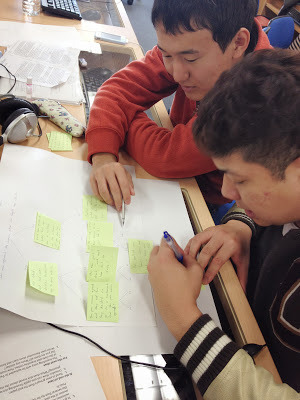COETAIL--Encounter Plotting: Course 4 Final Project
Another post toward obtaining my Certificate in Educational Technology and Information Literacy (COETAIL)
In a previous post I wrote about experimenting with Twine and Interactive Fiction.
For my COETAIL Course 4 Final Project, I decided to use TWINE and interactive fiction with my university creative writing students. My aim was to encourage them to consider multiple plot possibilities in an exercise prior to writing story starts (the first 300-500 words of a short story) in the "encounter" category (one of four categories of stories I use in this course). My students sometimes get stuck with plots, able to write a beginning, but unable to imagine obstacles and varied outcomes to carry a story through to an interesting and unpredictably fresh ending. I wondered if Twine would help students see that there are an infinite number of possible outcomes for any given story beginning.
Although we met in the language lab for this class period, rather than take up considerable class time with students learning how to create with Twine, I opted to have students use Post-Its on large sheets of paper. After class I would upload the resulting branching story to Twine.

Here is the plan I created for my lesson Twine--Branching Story: Encounter Plotting.
The plan worked well except for one oversight which meant that what resulted was actually four separate group stories rather than four branches of one story. I should have had the class collaboratively map the story until there were four branches, then set each of the four groups to work on a different branch. Regardless of that misstep on my part, the exercise seemed effective and students were immediately immersed in crafting the choices for the story. Since we had a limited amount of time for this lesson, some of the branches created by our class groups and pairs were incomplete or redundant, so I combined some branches and added some missing endings. The resulting story "Disco Encounter" below is a compilation of the many branches that students and I wrote--making it a completely collaborative project. It's a bit rough, and there are sections that definitely needed more proofreading, but the process was far more important than the product in this exercise.Click Disco Encounter to read the class story created with Twinery.org. (Press RESTART, or refresh to reload, and start the story again to try different branching options.)
Since we had a limited amount of time for this lesson, some of the branches created by our class groups and pairs were incomplete or redundant, so I combined some branches and added some missing endings. The resulting story "Disco Encounter" below is a compilation of the many branches that students and I wrote--making it a completely collaborative project. It's a bit rough, and there are sections that definitely needed more proofreading, but the process was far more important than the product in this exercise.Click Disco Encounter to read the class story created with Twinery.org. (Press RESTART, or refresh to reload, and start the story again to try different branching options.)

There are many ways in which this lesson might be improved or altered. In future I would allow more time for creating the story branches in class, and I would make certain that the initial branches were equal to the number of groups or pairs collaborating. An alternative would be to allow significantly more time for students to learn to create online with Twine and each group or pair to create their own original branching story.
But as an exercise to limber up their story plotting muscles, the Post-It method worked well, and my inclination would be to have students create the branches with Post-Its and paper again.
The Encounter story starts created subsequent to completing this exercise were overall more ambitious and engaging, and a number of them are now under development--becoming complete short stories that I look forward to reading.
In a previous post I wrote about experimenting with Twine and Interactive Fiction.
For my COETAIL Course 4 Final Project, I decided to use TWINE and interactive fiction with my university creative writing students. My aim was to encourage them to consider multiple plot possibilities in an exercise prior to writing story starts (the first 300-500 words of a short story) in the "encounter" category (one of four categories of stories I use in this course). My students sometimes get stuck with plots, able to write a beginning, but unable to imagine obstacles and varied outcomes to carry a story through to an interesting and unpredictably fresh ending. I wondered if Twine would help students see that there are an infinite number of possible outcomes for any given story beginning.
Although we met in the language lab for this class period, rather than take up considerable class time with students learning how to create with Twine, I opted to have students use Post-Its on large sheets of paper. After class I would upload the resulting branching story to Twine.

Here is the plan I created for my lesson Twine--Branching Story: Encounter Plotting.
The plan worked well except for one oversight which meant that what resulted was actually four separate group stories rather than four branches of one story. I should have had the class collaboratively map the story until there were four branches, then set each of the four groups to work on a different branch. Regardless of that misstep on my part, the exercise seemed effective and students were immediately immersed in crafting the choices for the story.
 Since we had a limited amount of time for this lesson, some of the branches created by our class groups and pairs were incomplete or redundant, so I combined some branches and added some missing endings. The resulting story "Disco Encounter" below is a compilation of the many branches that students and I wrote--making it a completely collaborative project. It's a bit rough, and there are sections that definitely needed more proofreading, but the process was far more important than the product in this exercise.Click Disco Encounter to read the class story created with Twinery.org. (Press RESTART, or refresh to reload, and start the story again to try different branching options.)
Since we had a limited amount of time for this lesson, some of the branches created by our class groups and pairs were incomplete or redundant, so I combined some branches and added some missing endings. The resulting story "Disco Encounter" below is a compilation of the many branches that students and I wrote--making it a completely collaborative project. It's a bit rough, and there are sections that definitely needed more proofreading, but the process was far more important than the product in this exercise.Click Disco Encounter to read the class story created with Twinery.org. (Press RESTART, or refresh to reload, and start the story again to try different branching options.)
There are many ways in which this lesson might be improved or altered. In future I would allow more time for creating the story branches in class, and I would make certain that the initial branches were equal to the number of groups or pairs collaborating. An alternative would be to allow significantly more time for students to learn to create online with Twine and each group or pair to create their own original branching story.
But as an exercise to limber up their story plotting muscles, the Post-It method worked well, and my inclination would be to have students create the branches with Post-Its and paper again.
The Encounter story starts created subsequent to completing this exercise were overall more ambitious and engaging, and a number of them are now under development--becoming complete short stories that I look forward to reading.
Published on December 18, 2013 19:01
No comments have been added yet.



